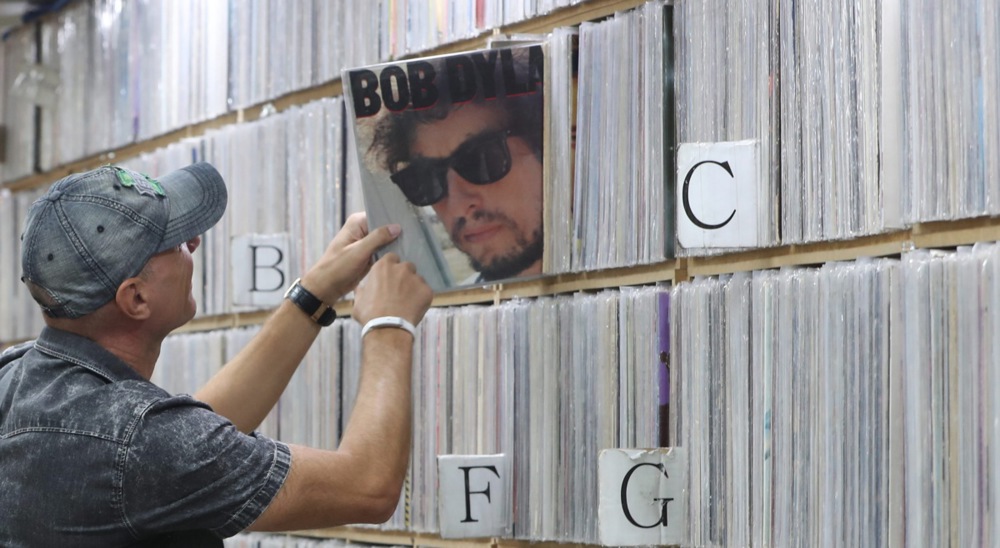Some have loved it, some have hated it, and some have flat-out refused to see it, knowing it cannot possibly be “good”, would be a waste of time, or worse, would pollute the legend, defile the majesty, hack at the towering stature of (their image of) the greatest artist of the past 100 years. Curmudgeonly, they are called. The retort is that those who have swallowed the artificially sweetened content of the movie are irredeemably easy to nostalgically satisfy, and too eager to buy a fairytale that is contrary to everything, or whatever, Dylan signifies.
A Complete Unknown has certainly got a lot of chatter going – that’s always a good thing – and seemingly a new generation of Dylan enthusiasts has been born through the spectacle of James Mangold’s telling of Dylan’s pre-1967 career (basically the folk and first electric years) with the talented Timothée (or Timmy, as Dylan has referred to him) Chalamet in the starring role.
Chalamet has acquitted himself as a talented actor turning in a bunch of good to very good performances before this. Indeed Timmy, we are told, as corroboration of his dramatic chops, spent lockdown learning to play the guitar and sing like Dylan – enough like Dylan, in fact, that several of the movie’s live performances are voiced by him. This is the kind of Hollywood big-upping that should raise an eyebrow: it brings us no closer to Dylan’s genius and is plain old skilled mimicry (by this token I am left with the absurd notion of Forest Whitaker actually playing the alto saxophone parts of Charlie Parker in Clint Eastwood’s sombrely reverential Bird; an accomplishment that would have needed more than a few lockdowns to master the saxophone wizardry of the forlorn Yardbird).
But there’s something ridiculously appropriate in the fact that Dylan – the victim of endless imitators and perpetrators of butchery on his colossal catalogue of songs (some honourable exceptions – personal favourites – are listed below) – should now have his persona, as well as his music, the subject of a dubiously meticulous onscreen “cover version”.
What ironies abound in the soundtrack album accompanying the film, featuring versions of songs designed to sound as near to the originals as possible.
In another time it could have featured as a segment in the sly, layered masterpiece on tricksterism and forgery made by Orson Welles, F For Fake (1973). And in this regard the terrific Rolling Thunder Revue – a compendium of documentary, gleefully twisted facts and mischievous myth-making and antic piss-taking – is very much the final word in revealing, thrillingly, the unrevealable.
Dylan’s mystery, thankfully, remains impervious to explanation.
The biopic is a genre that is unavoidable and predictable in our terminally recyclable culture. It helps that it has the long-tested music assets to exploit, hence the Elton John, Queen and inevitable Elvis movies.
As we know it today, the biopic proceeds on the following premise: some imposed sense of historical order is curated on the unknowable life stories of popular artists and dramatised under the direction of someone whose fandom is manifest and portrayed by an actor who aspires to “accuracy” and authenticity and getting properly under the skin of their subject.
With Dylan this is beyond impossible: we recall how early on he remarked that his show, all music performances are “an act”. But actors routinely make the mistake that musicians are baring themselves onstage, are honest, are “real”. They tend to believe the artist – especially one of Dylan’s ilk – is not “acting”.
It is of interest that Chalamet as Dylan won the award that is chosen by actors (the 2025 SAG best actor award) but not the Hollywood biz-voted Oscar.
There’s not a lot to be said for the music biopic – I can’t think of one really good one. Is there a more debased, vampiric form of moviemaking?
Greil Marcus, the esteemed Dylanologist, has been charitable to A Complete Unknown (his Substack piece which refers could equally reasonably be described as damning with faint praise) and even though I’m disposed to loathing the movie in any case, director Mangold was at the helm of the halfway redeemable Johnny Cash biopic, Walk the Line.
But that was purely due to the fabulous performance by Joaquin Phoenix and the screen chemistry between him and Reese Witherspoon (as June Carter Cash).
Then again, the more you think about the “real” Johnny and June, the less the film convinces, but Phoenix and Witherspoon do transcend the hokey thinness with old-fashioned movie star romance and charisma.
This Dylan movie, however, aims to make a museum piece out of the Woody/Newport/”Judas”/Triumph motorcycle tropes, reproduced to convey a form of simple narrative linearity, to rearrange posterity for history.
The point – or at least a point – is that there is so much primary Dylan material to feast on, for curious newcomers and the devoted adherents alike. And especially for the curmudgeonly.
style="font-weight: 400;">Don’t Look Back, and there’s the ‘65 San Francisco




 A customer looks at a Bob Dylan album at a record shop in Seoul, South Korea, on 14 October 2016. (Photo: EPA / Yonhap / South Korea out
A customer looks at a Bob Dylan album at a record shop in Seoul, South Korea, on 14 October 2016. (Photo: EPA / Yonhap / South Korea out /file/dailymaverick/wp-content/uploads/2025/03/12747088.jpg)